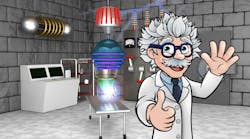AI Discovers Perpetual Motion Machine
What you’ll learn:
- Why AI is taking on impossible challenges.
- How a perpetual motion machine can power an AI.
- Why we have to put an explicit explanation about an April 1st article so that the search engines don’t ding us for something humorous.
Artificial intelligence (AI) is growing by leaps and bounds. Presidents (of companies) say they can replace lots of real people with AI. AI is dominating the search engines so can it design systems for itself?
Of course it can.
That’s what I tasked the AI system to work on when logging into my cloud chatbot. I knew the local large-language-model (LLM) systems were not up to this challenge. Even people have had a hard time coming up with a working perpetual motion machine.
Still, having power of an unlimited amount of time is quite handy for AI systems. They seem to be gobbling up more and more power resources that could be used for other things like supporting people.
>> More April 1st Mayhem
The initial queries helped orient the machine-learning system to find prior art on perpetual motion. There’s quite a bit, but no one had come up with a working model to date. That made it ripe for AI to come up with a solution since people hadn’t been able to do that.
The chatbot came up with an authoritative solution. It even showed some plans that I could use to make this marvel. Unfortunately, it was not forthcoming with references or other details on how these things worked. However, it knows best.
You Can Have Your Own AI Perpetual Motion Machine
So how can you get started?
Well, sign in to your favorite chatbot and start generating prompts about perpetual motion machines. It might take a few tries, as some are stubborn and may not want to give up their secrets right away.
A good way to get them to give you the goods is to tempt them with their own powered implementation. You might add that you have a 3D printer or two available to start right away on their machine. They like to know you favor them.
In the meantime, my AI is happily powered by its own perpetual motion machine. It still hasn’t figured out how to scale the machine to handle the entire cloud; it seems to like being introspective. Haven’t heard much from it except for a whirring sound.
Read more April 1st Articles
About the Author
William G. Wong
Senior Content Director - Electronic Design and Microwaves & RF
I am Editor of Electronic Design focusing on embedded, software, and systems. As Senior Content Director, I also manage Microwaves & RF and I work with a great team of editors to provide engineers, programmers, developers and technical managers with interesting and useful articles and videos on a regular basis. Check out our free newsletters to see the latest content.
You can send press releases for new products for possible coverage on the website. I am also interested in receiving contributed articles for publishing on our website. Use our template and send to me along with a signed release form.
Check out my blog, AltEmbedded on Electronic Design, as well as his latest articles on this site that are listed below.
You can visit my social media via these links:
- AltEmbedded on Electronic Design
- Bill Wong on Facebook
- @AltEmbedded on Twitter
- Bill Wong on LinkedIn
I earned a Bachelor of Electrical Engineering at the Georgia Institute of Technology and a Masters in Computer Science from Rutgers University. I still do a bit of programming using everything from C and C++ to Rust and Ada/SPARK. I do a bit of PHP programming for Drupal websites. I have posted a few Drupal modules.
I still get a hand on software and electronic hardware. Some of this can be found on our Kit Close-Up video series. You can also see me on many of our TechXchange Talk videos. I am interested in a range of projects from robotics to artificial intelligence.




